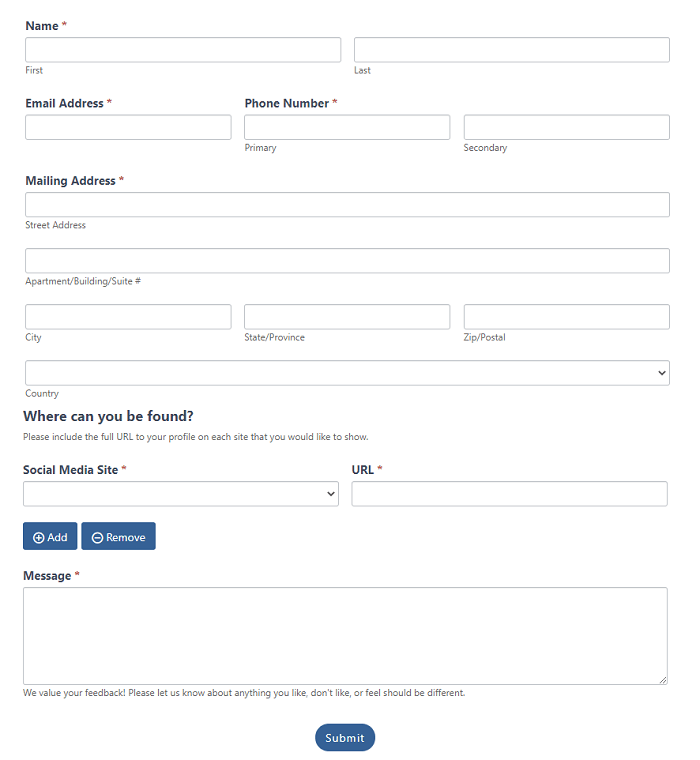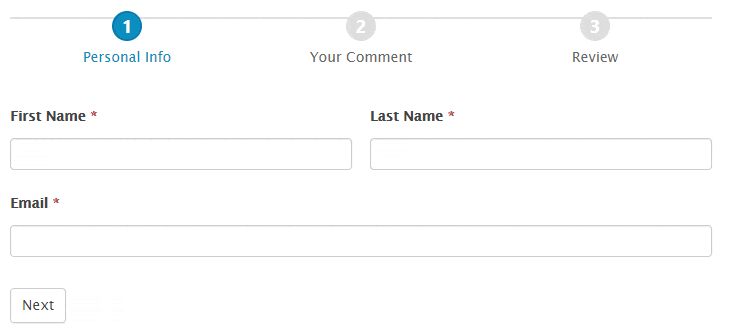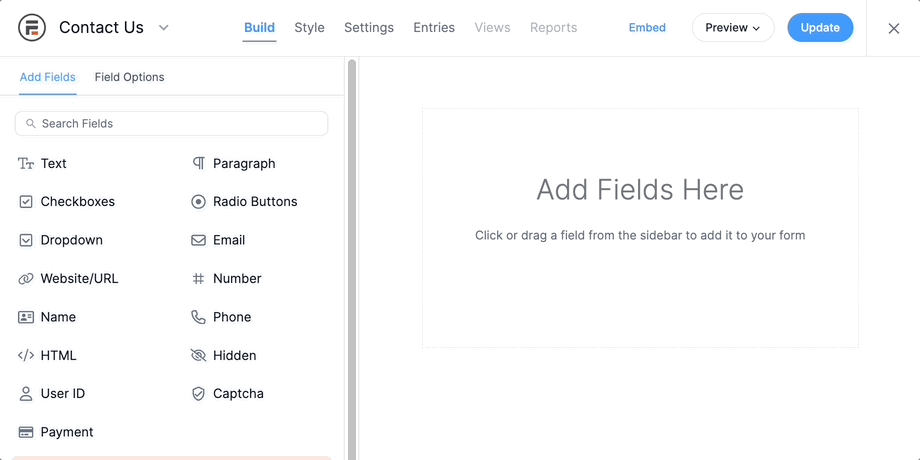Learn how to use form abandonment tracking to stop losing leads. Follow our tips to track form abandonment, optimize user experience, and increase leads.

Approximate read time: 7.5 minutes
Struggling with form abandonment issues?
It's frustrating to see that site visitors aren't completing your forms, whether payment forms or brand awareness surveys. Well, we're here to help! And we won't even ask you to lie on a couch and spill your secrets!
Instead, let's talk about form abandonment tracking and two different ways to add it to your WordPress website.
First, we'll quickly cover how to use Google Tag Manager to track abandoned forms. Then, we'll show you an even easier option using Formidable Forms' form abandonment tracking feature.
Start Tracking Form Abandonment Now!
Let's get you more leads and help you convert more customers.
Understanding form abandonment
Before we discuss implementing form abandonment tracking in WordPress, let's define form abandonment and consider how measuring it can improve your site's success.
What is form abandonment?
Form abandonment is when a website visitor starts filling out a form but doesn't complete it. It's like when someone walks into a store, picks up a couple of items, and then leaves without buying anything.
In the digital realm, it's the equivalent of users saying, "I'm interested, but not THAT interested." 😔
So, why aren't people finishing my forms?
Some of the most common reasons users quit filling out a form include confusing questions, long forms, technical errors, and slow loading times.

Whatever the cause, web form abandonment can deal a big blow to your form conversion rates and, ultimately, your bottom line.
How can I reduce form abandonment?
The first step to decreasing form abandonment is to use form analytics to pinpoint where the problem lies. 📌
One of the fastest and easiest ways is to simply test your form so you can better understand users' experience.
Realizing your form takes forever to fill out? ⏳ Start by simplifying your form as much as you can. Here are a few guidelines to follow:
- Make your form as short as possible: Only ask for information that's absolutely necessary. The more questions, the less likely users are to finish your form. Try using conditional logic, multi-page forms, and conversational forms.
- Give clear and concise instructions: Make sure users know exactly how to respond to each form field.
- Show their progress: Show users how far they've come and how much is left to fill out so the end is always in sight.
- Use a clean and intuitive design: Keep things clutter-free and user-friendly for a smoother experience.

After you've streamlined your form and addressed other obvious issues, it's time to dig into the data! 🤓
Form abandonment tracking
If you really want to improve conversion rates, abandonment tracking should be next on your to-do list.
To measure form abandonment, you track and analyze user interactions with your forms. But don't worry, you don't have to do all the sleuthing yourself. There are some great tools out there that give you the clues you need!
How do I track form abandonment in WordPress?
In WordPress, you can use Google Tag Manager or a form builder plugin with built-in tracking features like Formidable Forms.
Both solutions automatically show you when someone starts filling out a form but doesn't submit it. And you can deduct a lot from this data, including motives for quitting forms and optimization opportunities to investigate. 🕵️♂️
But be prepared; these two methods are about as different as Sherlock Holmes and Dr. Watson.
One requires coding knowledge plus skills in Google Analytics and Google Tag Manager. For the other, you just need to know how to install a WordPress plugin.
Ready to solve the mystery of unfinished forms? 🔎 The game is afoot! Let's go!
Add tracking with Google Tag Manager & GA4
⚠️ To use Google to track form abandonment, you'll need to be able to edit the code of your website and configure event tags in Google Analytics. If you don't know how or simply don't want to, you'll want to use the Formidable Forms method instead.
Still a go for Google? Great, let's get started.
First, create a Google Tag Manager account (GTM) and set up a container for your site. Next, install the GTM container on your WordPress website by adding the code snippet in the site header.
Back in your GTM account, Add a new tag to your container, and then create a custom Trigger to detect when a form is started but not completed.

Now pop over to Google Analytics to create a GA4 event tag for tracking these abandonment events. Once your GA4 event tag is set up, go back to GTM to connect the GA4 Configuration tag.
Clear as mud, right?! 😳 Don't worry, we're almost done!
All that's left is to save your tag, then preview and debug in GTM. If everything's working, hit Submit to start collecting data!
Not exactly "elementary," is it? If you're still scratching your head, read on for a much easier way to get analytics tracking on WordPress forms. 👇
Add tracking with Formidable Forms

To track form abandonment on your WordPress site, you'll need a Formidable Business Plan or above.
Get Formidable Form Abandonment Tracking!
When you have your license, install and activate the plugin, and you're ready to go!
Step 1: Install the add-on
In your WordPress admin, go to Formidable → Add-Ons. Find the WordPress Form Abandonment plugin, then click Install, and finally, Activate.

Step 2: Edit a form or create a new one
Next, go to Formidable → Forms. Either Edit an existing form or hit the blue + Add New button.
If you're making a new form, you can choose from one of Formidable's 225+ online form templates to save time. Or build a form from the ground up by selecting Blank Form.
Now it's time to create or customize your form in the drag and drop form maker!

Double-click a field to add it to your form, or click and drag it exactly where you want it on the right side of the screen. To edit a form field, select it inside the form preview and adjust the settings on the left side of the screen.
When you're finished, click Update to save your form.
Step 3: Set up form abandonment
While still in the form builder, head to the Settings tab at the top of the screen. Scroll down and open the Form Abandonment tab.
Click Turn on form abandonment to capture partial form submissions. Yep, it only takes one click!

And you can also choose whether to capture all partial entries or Only save entries with an email address or phone number provided. Obviously, you'll need a phone number or email field in your form if you pick this option.

Step 4: Create a basic form recovery email
The last step is to set up an automatic email encouraging visitors who abandoned the form to complete it. All you have to do is click the Create a recovery email button and personalize the text.
If you aren't sure what to write, check out these abandoned cart email examples for some inspiration.

Hit Update one last time to save your form settings, and then publish your form to start collecting partial entries.
Great going, gumshoe! You're all set to stake out those lost leads! 👀
See when users abandon your forms
Check the status of your WordPress form entries by going to Formidable → Entries. Then, select your form from the dropdown menu in the upper left of the page.
You should now see something like this:

View an abandoned entry to see where they stopped filling out your form. For even easier analysis, you can set up user tracking and use Formidable Reports to show charts and graphs of this data.

Ready to get rid of your WordPress form abandonment woes?
Thankfully, solving your form "abandonment issues" doesn't require a session with a shrink 🧠. And you don't need a detective to track form abandonment rates in real-time, either 🕵️.
You just need to configure Google Tag Manager + Google Analytics, or install the easy-to-use, all-in-one WordPress form plugin Formidable Forms. The choice is yours!
Ready to follow the trail of those lost leads and turn them into satisfied clients?
Try Formidable Pro risk-free for 14 days with our 100% money-back guarantee.
Did you know our WordPress form maker can also help with abandoned carts? It's true! Here's how to reduce shopping cart abandonment with Formidable.
 How To Add a Google Map to a WordPress Contact Form [Free!]
How To Add a Google Map to a WordPress Contact Form [Free!] 9 Contact Form Best Practices for High-Converting Forms
9 Contact Form Best Practices for High-Converting Forms How To Save Form Progress in WordPress [4 Steps!]
How To Save Form Progress in WordPress [4 Steps!]
It seemed a bit complicated, but I guess it works.
The article hits the nail on the head with the issue of form abandonment, a common yet overlooked problem that many online businesses face. Not only does this issue impact potential revenue, but it can also provide pivotal insights into user behavior and website performance.
The tone is both witty and engaging, making a typically technical topic more approachable for readers. It's clever to offer a sense of humor about a subject that might otherwise be a bit dry, which can help business owners feel less alone with their challenges.
The breakdown of solutions is particularly valuable. By starting with a more advanced technique like using Google Tag Manager and then offering a simpler solution through Formidable Forms, you cater to a wide range of technical abilities and preferences. It's smart to acknowledge that while some users might be comfortable diving into analytics, others will appreciate a more straightforward method.
The call-to-action to start tracking form abandonment is compelling, emphasizing the benefits of understanding why users may leave forms incomplete. It's a reminder that every interaction, or lack thereof, on a website is an opportunity to learn and improve.
I'm intrigued by the potential depth of data that can be gleaned from tracking form abandonment and would be interested in learning more about how these insights can be translated into actionable strategies to reduce abandonment rates. It might also be helpful to discuss best practices for form design and user engagement to complement the technical advice provided.
Overall, this article does a fantastic job of addressing a common pain point for website owners and providing clear, actionable solutions to help improve lead generation and customer conversion.
Really useful resource for those who want to generate leads.
Love formidable forms, I didn't know you could do this with it.
This is why i love formidable, they are constantly adding new perks.. ive been using for over a decade - they just keep getting better.
By far the best form plugin available for WP - and the depth of what you can do is incredible.
Very informative read. Thanks.
Some great information
Very informative thank you for sharing.
very useful info, thanks)!
Cool!
Great information thanks!
Thanks for sharing! This is really helpful for those customers on the fence! Great tool to help close that deal/sale!
Good to know!
Never knew about this!
Very in depth thanks
best plugin for wordpress
I wasn't initially interested in this feature, but after reading more it seems like it was very well-thought out in its implementation. Even for internal company use, it seems there could be uses for long forms where a user isn't able to finish their submission in one go, and this would help prompt them with link to resume their entry after a period of time. Looking forward to digging more into it!
thanks for sharing the info! very helpful
I have a client with this very problem - going to pitch this solution!
useful info
Interesting and helpful
Great insights on using Formidable Forms! The tips on abandonment tracking are valuable for optimizing lead retention. Thanks for sharing!
I love how this feature allows us to contact users and nugde them towards completing the form. Looking forward to implementing it on all crucial forms.
This is really important info to track - when users have issues with my form, I want to know right away so I can address it!
Absolutely critical info to have for a successful ecommerce store. And speaking of commerce, would love to see a tutorial on how to manage variable subscription products with Formidable Forms in WooCommerce. Talk about being thankful on Thanksgiving - schwing!
Short forms with clear instructions, seems to be the best way to go.
This form looks neat, thank you for sharing
A clever feature. Everyone gets busy, You on a call with someone, a client walks in and you say you going to call back and never do. This feature gives you that advantage of keeping the ball rolling.
Really needed to read this.
We will sometimes do a giveaway on our site and ask people to fill out very basic info.
I have been told they don't like filling out the form and therefore choose not to enter.
Is there a way we can make it more easy or entertaining to fill out the form?
Thank you for sharing.
When I first heard of form abandonment, I thought you meant forms that users no longer utilize and/or aren't linked anywhere on a site. But this makes way more sense. Ha!
Excellent guide and valuable information.
This is a great feature, I will not be using for a simple reason: I don't want to add a cookie acceptance click on my website. And to remain compliant with privacy laws, I can't collect complete IPs and track users this way.
Privacy of my users is more important than abandonment at this stage. There are really good tips at the beginning on how to reduce abandonment by making the form relevant and simpler. All users are not clients, so I am fine with losing some on the way.
Testing the forms with clients and understanding the journey is my way of reducing abandonment, rather than using tracking tech.
Nice guide, thank you for sharing!